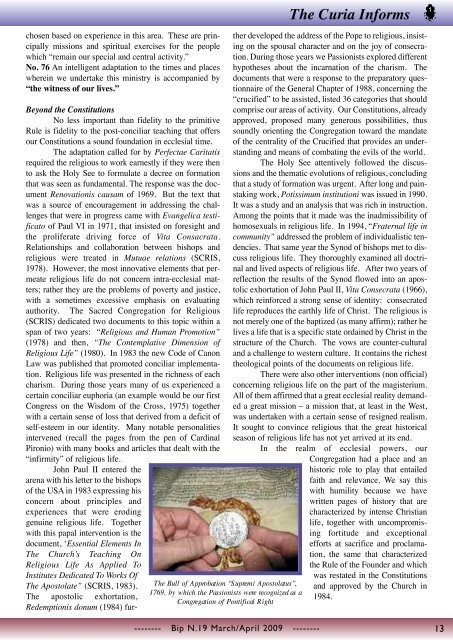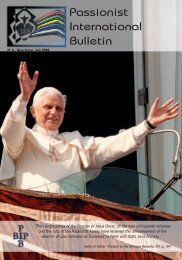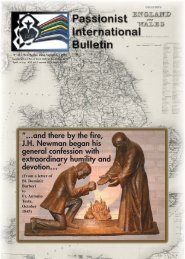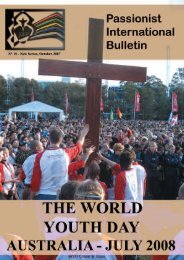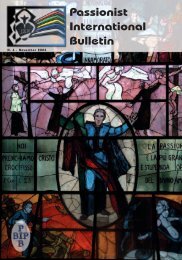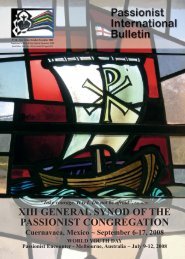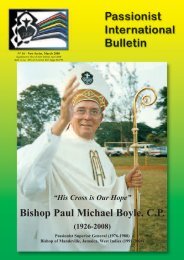The Curia Informs - Passio Christi
The Curia Informs - Passio Christi
The Curia Informs - Passio Christi
Create successful ePaper yourself
Turn your PDF publications into a flip-book with our unique Google optimized e-Paper software.
chosen based on experience in this area. <strong>The</strong>se are principally<br />
missions and spiritual exercises for the people<br />
which “remain our special and central activity.”<br />
No. 76 An intelligent adaptation to the times and places<br />
wherein we undertake this ministry is accompanied by<br />
“the witness of our lives.”<br />
Beyond the Constitutions<br />
No less important than fidelity to the primitive<br />
Rule is fidelity to the post-conciliar teaching that offers<br />
our Constitutions a sound foundation in ecclesial time.<br />
<strong>The</strong> adaptation called for by Perfectae Caritatis<br />
required the religious to work earnestly if they were then<br />
to ask the Holy See to formulate a decree on formation<br />
that was seen as fundamental. <strong>The</strong> response was the document<br />
Renovationis causam of 1969. But the text that<br />
was a source of encouragement in addressing the challenges<br />
that were in progress came with Evangelica testificato<br />
of Paul VI in 1971, that insisted on foresight and<br />
the proliferate driving force of Vita Consacrata.<br />
Relationships and collaboration between bishops and<br />
religious were treated in Mutuae relations (SCRIS,<br />
1978). However, the most innovative elements that permeate<br />
religious life do not concern intra-ecclesial matters;<br />
rather they are the problems of poverty and justice,<br />
with a sometimes excessive emphasis on evaluating<br />
authority. <strong>The</strong> Sacred Congregation for Religious<br />
(SCRIS) dedicated two documents to this topic within a<br />
span of two years: “Religious and Human Promotion”<br />
(1978) and then, “<strong>The</strong> Contemplative Dimension of<br />
Religious Life” (1980). In 1983 the new Code of Canon<br />
Law was published that promoted conciliar implementation.<br />
Religious life was presented in the richness of each<br />
charism. During those years many of us experienced a<br />
certain conciliar euphoria (an example would be our first<br />
Congress on the Wisdom of the Cross, 1975) together<br />
with a certain sense of loss that derived from a deficit of<br />
self-esteem in our identity. Many notable personalities<br />
intervened (recall the pages from the pen of Cardinal<br />
Pironio) with many books and articles that dealt with the<br />
“infirmity” of religious life.<br />
John Paul II entered the<br />
arena with his letter to the bishops<br />
of the USA in 1983 expressing his<br />
concern about principles and<br />
experiences that were eroding<br />
genuine religious life. Together<br />
with this papal intervention is the<br />
document, ‘Essential Elements In<br />
<strong>The</strong> Church’s Teaching On<br />
Religious Life As Applied To<br />
<strong>The</strong> Bull of Approbation “Supremi Apostolatus”,<br />
1769, by which the <strong>Passio</strong>nists were recognized as a<br />
Congregation of Pontifical Right<br />
<strong>The</strong> <strong>Curia</strong> <strong>Informs</strong><br />
Institutes Dedicated To Works Of<br />
<strong>The</strong> Apostolate” (SCRIS, 1983).<br />
<strong>The</strong> apostolic exhortation,<br />
Redemptionis donum (1984) further<br />
developed the address of the Pope to religious, insisting<br />
on the spousal character and on the joy of consecration.<br />
During those years we <strong>Passio</strong>nists explored different<br />
hypotheses about the incarnation of the charism. <strong>The</strong><br />
documents that were a response to the preparatory questionnaire<br />
of the General Chapter of 1988, concerning the<br />
“crucified” to be assisted, listed 36 categories that should<br />
comprise our areas of activity. Our Constitutions, already<br />
approved, proposed many generous possibilities, thus<br />
soundly orienting the Congregation toward the mandate<br />
of the centrality of the Crucified that provides an understanding<br />
and means of combating the evils of the world.<br />
<strong>The</strong> Holy See attentively followed the discussions<br />
and the thematic evolutions of religious, concluding<br />
that a study of formation was urgent. After long and painstaking<br />
work, Potissimum institutioni was issued in 1990.<br />
It was a study and an analysis that was rich in instruction.<br />
Among the points that it made was the inadmissibility of<br />
homosexuals in religious life. In 1994, “Fraternal life in<br />
community” addressed the problem of individualistic tendencies.<br />
That same year the Synod of bishops met to discuss<br />
religious life. <strong>The</strong>y thoroughly examined all doctrinal<br />
and lived aspects of religious life. After two years of<br />
reflection the results of the Synod flowed into an apostolic<br />
exhortation of John Paul II, Vita Consecrata (1966),<br />
which reinforced a strong sense of identity: consecrated<br />
life reproduces the earthly life of Christ. <strong>The</strong> religious is<br />
not merely one of the baptized (as many affirm); rather he<br />
lives a life that is a specific state ordained by Christ in the<br />
structure of the Church. <strong>The</strong> vows are counter-cultural<br />
and a challenge to western culture. It contains the richest<br />
theological points of the documents on religious life.<br />
<strong>The</strong>re were also other interventions (non official)<br />
concerning religious life on the part of the magisterium.<br />
All of them affirmed that a great ecclesial reality demanded<br />
a great mission – a mission that, at least in the West,<br />
was undertaken with a certain sense of resigned realism.<br />
It sought to convince religious that the great historical<br />
season of religious life has not yet arrived at its end.<br />
In the realm of ecclesial powers, our<br />
Congregation had a place and an<br />
historic role to play that entailed<br />
faith and relevance. We say this<br />
with humility because we have<br />
written pages of history that are<br />
characterized by intense <strong>Christi</strong>an<br />
life, together with uncompromising<br />
fortitude and exceptional<br />
efforts at sacrifice and proclamation,<br />
the same that characterized<br />
the Rule of the Founder and which<br />
was restated in the Constitutions<br />
and approved by the Church in<br />
1984.<br />
-------- Bip N.19 March/April 2009 -------- 13


